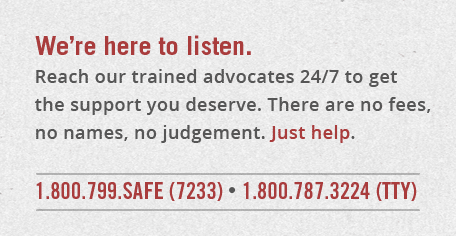Introduction
• Also see Help & Healing: Abuse
Each year the lives of women (and men) are altered or destroyed by someone who abuses them. The resulting emotional scars, physical scars, and destruction are evident in social and crime statistics.
Although abuse is significantly under-reported, current crime statistics at least begin to tell the story. The FBI’s Uniform Crime Report routinely lists domestic violence as the leading cause of injury to women ages 15 to 44 in the United States. These injuries are more than those from car accidents, muggings, and rapes combined.

Abuse may be open, flagrant, and in-your-face. But abuse can also be subtle and devious. It may explode on the scene or gradually creep into a relationship. Although women are the primary victims of abuse, men may be victims, also, of abuse.
One of the first steps in dealing with abuse is to identify it. Identifying it is often difficult because it can manifest itself in different forms. Here is a brief survey of the different types of abuse.
- Emotional abuse is the use of mental strategies or mind games. This would include such things as anger, aggression, humiliation, intimidation, stalking, fear, power, and control. The goal is to inflict emotional damage on the other person.
- Physical abuse would include the use of body parts or weapons to threaten, punish, dominate, restrain, control, or injure another person.
- Sexual abuse is the use of forced sexual actions which may dominate, manipulate, threaten, injure, corrupt, or control another person.
- Social abuse involves other forms of abuse to dominate, manipulate or control another person’s social relationships.
- Financial abuse is the use of money or financially-related matters to dominate, threaten or control. This may be done to inflict damage on another person or take financial advantage of that person.
- Spiritual abuse is the controlling of another person’s religious interests or practices. Spiritual damage may be inflicted by criticizing a person’s religious convictions or misstating them for religious purposes.
Although abuse may take various forms, there are often common elements. For example, there often is the tendency to blame the victim of abuse. A woman may be told to “submit” or “pray harder for her marriage” by a pastor or church members. And often women go back into abusive relationships, leaving many to wonder.
In this article, we will try to provide some answers and perspective on this important issue. (And I might note that we already have articles on the Probe Web site dealing with such issues as verbal abuse and spiritual abuse.)
Types of Abusers
Although abuse and domestic violence are one of the most pressing social problems of our time, most of society (including churches) still view the crisis as a private matter. Abused women are often advised by pastors and members of a congregation to “pray harder” or “try to become a better wife.”
Abuse has not only been ignored by the church but often by the medical profession. In their study of abuse, Evan Stark and Ann Flitcraft found that out of one million women who sought medical treatment for injuries sustained by husbands and boyfriends, doctors correctly identified the injuries as a result of battering only four percent of the time.{1}
Frequently child abuse and domestic violence go hand in hand. Men who abuse their wives will often also abuse their children. Research shows that in homes where domestic violence occurs, children are abused at a rate 1500 percent higher than the normal average.{2}
Often this abuse begins even before a child is born. One study of 1200 white, Latino, and African-American pregnant women, found that one in six reported physical abuse during pregnancy.{3}
Researchers now conclude that there are two types of abusers. Neil Jacobson and John Gottman document this in their book, When Men Batter Women.{4} Their study of more than 200 couples in dangerous relationships helped shatter myths and shed new light on abusive relationships.
They describe two types of batterers: Cobras and Pit Bulls. The Cobras are more severely violent of the two. They strike swiftly and ferociously, always remaining in control and feeling entitled to whatever they want.
Pit Bulls are violent because they are insecure. They are more likely to lose control, letting their emotions burn slowly until they explode in anger.
Jacobson and Gottman intensively studied about 60 of the 200 couples by watching videotapes of non-violent arguments of severe batterers and their spouses. To eliminate some of the subjectivity, they also monitored the vital signs (heart rate, sweat flow) of the couples.
They found that Cobras resemble the snake for which they are named. They become still and focused just before striking their victim. They become internally calm during abuse. While the heart rates of Pit Bulls increase during abuse, the Cobras’ heart rates actually decrease.
Pit Bulls are driven by deep insecurity and often have an unhealthy dependence on the mates they abuse. They are afraid of losing their wives and therefore try to control them through physical and emotional abuse. Cobras have often been physically or sexually abused themselves (frequently in childhood) and tend to see violence as an unavoidable part of life.
Boundaries
Often victims of abuse feel they deserve the abuse they receive. They have been convinced (by their partner or perhaps by society in general) that the abuse is their fault. It is not. To reinforce this claim, here are eight things that no one deserves:{5}
- No one deserves to be pushed, slapped, bruised, or kicked. No excuse makes such actions justifiable, whether drugs, alcohol, financial problems or family problems.
- No one deserves to be verbally abused. No one should be called names or yelled at for no apparent reason.
- No one deserves to have possessions damaged (dishes thrown, clothes torn) or gifts destroyed. These things don’t automatically become “his” just because he paid for them from a joint checking account.
- No one deserves to be interfered with in coming and going. You do not need to be told when you can or cannot leave the house, go shopping, or go to school.
- No one deserves to be followed, harassed, or spied upon. As an adult, you have the right to go where you want, and spend time the way you choose.
- No one deserves to be ridiculed, put down, made fun of, or belittled. This applies both at home and in public.
- No one deserves to be emotionally starved. Everyone has emotional needs: to love, to be loved, to care and be cared for, to need others and to be needed by others. This involves more than just one person who is demanding your time and attention.
- No one deserves to be isolated. You deserve to have a community of people around you rather than just a spouse who dominates your life.
Each person has rights that should be asserted to prevent abuse from taking place. Here is a short list of those rights:
- You have the right to be treated with respect. All are created in the image of God (Gen. 2:26-27) and have value and dignity. You deserve respect regardless of your economic status, race, religion, or sex.
- You have the right to be heard. You have ideas and opinions and should be free to express them.
- You have the right to have a support system. You shouldn’t have to depend on one person in your life to provide all your emotional needs and who cuts you off from the rest of society.
- You have the right to come and go as you please. You should be able to make choices about what you do with your free time.
- You have the right to have privacy and space of your own. You don’t give up those rights when you get married or when you begin to have children.
- You have the right to maintain a separate identity.
Each of these rights are important in establishing boundaries in a relationship. These are key components in preventing abuse.
Myths of Abuse
Let’s turn now to some of the myths of abuse.{6}
One myth is that victims of abuse come from lower-income families with little education. In reality, victims of domestic violence come from all walks of life. Race, religion, socio-economic background are no predictor of abuse. Victims of abuse may be well-educated or uneducated, professionals or common laborers.
A second myth is that victims stay in abusive relationships because they like being abused. That is simply not true. Many have been conditioned to accept beatings because they are blamed by their abusers, but they do not like being beaten. Many victims actually “accept abuse as common in relationships.”{7}
So, why don’t victims leave? The answer to that is often quite complex. Many women believe they cannot leave because “He can’t live without me.” They may fear he will have a nervous breakdown, commit suicide, or lose his job.
She may believe that the children need a father, rationalizing that an abusive father is better than no father at all. And she may think she cannot make it alone in the job market.
Many women fear they will be killed if they leave an abusive relationship. And that fear may be justified. Studies show that battered women are more likely to be killed after leaving an abusive relationship.{8}
Abuse victims also convince themselves that things are going to get better. Hope springs eternal, and there is always the hope that with the right changes and hard work, abuse will go away. Sadly, it does not.
A third myth is that violence happens mostly between strangers. Contrary to popular belief, a woman’s greatest risk of assault is from an intimate partner. Statistics from the Department of Justice indicate that women are attacked seven times more often by offenders with whom they have an intimate relationship than are male victims of violence.{9}
A fourth myth is that abuse is not a major problem. Domestic violence is one of the most serious health problems today. As we have mentioned, it affects every socioeconomic segment of society. “Federal officials estimate that domestic violence costs U.S. firms $4 billion a year in lower productivity, staff turnover, absenteeism, and excessive use of medical benefits.”{10}
What the Church Can Do
Domestic violence is pervasive in our society and crosses all socioeconomic levels, religious belief, and cultural backgrounds. Abuse affects our lives, our homes, and our society. Is there anything the church can do to deal with this important issue? Here are a few suggestions.{11}
First, pastors and church members should be aware of the extent of the problem. I have provided some social statistics to demonstrate how pervasive abuse is within our society. It isn’t a problem to be ignored or addressed through simple clichés.
Second, pastors and counselors need to help abuse victims set boundaries in their lives. Battered women often find it difficult to make choices because someone else has been making decisions for them. Many women who live in violent homes went from their father’s house straight to their abuser’s house. They never have had much experience in making their own personal choices.
If you are seeking to help an abuse victim, you should encourage her to make her own decisions. Resist the temptation to rescue and take over her life. She needs to feel empowered not helpless. At the same time, you can provide suggestions about finding a family counselor or a domestic violence agency.
Third, if you are a pastor, a counselor, or just a caring friend, you can provide counsel and comfort. She needs to hear from you that she doesn’t deserve to be abused. Acknowledge the seriousness of the situation, and don’t let her convince herself that the abuse will go away.
Fourth, be prepared for crisis intervention. Quick action may be necessary to protect her and her children. Ask her to describe the circumstances of the last two or three beatings. What preceded his attack (drugs, alcohol, argument)? Where is her relationship right now?
A pastor or counselor who receives a crisis call only has a few moments to discern the extent of the threat and appropriate actions that should be taken. Can she find her way to a safe place immediately? Do you have a place for her to go, if necessary?
Sometimes the crisis arrives at your office or home. A pastor, counselor, or caring friend may need to arrange for medical attention and a safe place away from the abuser.
If the couple is separated, she may be stalked by her abuser. She needs to know who can protect her and how to contact legal services.
Fifth, the church should address this important issue of domestic abuse. By speaking to this issue, we break the silence surrounding abuse and confront it with biblical principles. The church should hold batterers responsible for their actions. Intervention, confrontation, and tough love should be tools used to fight abuse in our communities.
If the batterer is a member of the church, then Matthew 18 provides a model for confronting “offenders” within the church. Galatians 5:22-25 talks about the fruit of the Spirit with includes kindness, gentleness, and self-control. These and many other verses provide a model for teaching, rebuking, correcting and training in righteousness (2 Tim. 3:16). Christians have an important role in dealing with abuse within our society.
— Also see Abuse Resources
Notes
1. Evan Stark and Ann Flitcraft, “Medical Therapy as Repression: The Case of the Battered Woman,” Health and Medicine, 1982, 29-32.
2. Maria Roy, “Children in the Crossfire,” Health Communications, 1988.
3. Judith McFarlane, “Abuse During Pregnancy: A Cross-Cultural Study of Frequency and Severity of Injuries,” National Coalition Against Domestic Violence Fact Sheet (Denver, 1994).
4. Neil Jacobson and John Gottman, When Men Batter Women: New Insights into Ending Abusive Relationships (New York: Simon & Schuster, 1998).
5. A more detailed list can be found in Mary Marecek, Breaking Free from Partner Abuse (Buena Park, Calif: Morning Glory Press, 1999).
6. Andrea Lissette and Richard Kraus, Free Yourself from an Abusive Relationship (Alameda, Calif: Hunter House, 2000).
7. Eve Buzawa and Carl Buzawa, Domestic Violence: The Criminal Justice Response (Thousand Oaks, Calif: Sage Publications, 1996).
8. Mary Ann Dutton, “The Dynamics of Domestic Violence: Understanding the Response from Battered Women,” The Florida Bar Journal, October 1994.
9. “Violence Against Women: Estimates from the Redesigned Survey, August 1995,” Report from the U.S. Justice Department (Washington, DC: Bureau of Justice Statistics, 1996).
11. Patricia Riddle Gaddis, Battered But Not Broken (Valley Forge, Pa: Judson Press, 1996).
© 2003 Probe Ministries. Used with Permission. This document is the sole property of Probe Ministries. It may not be altered or edited in any way. Permission is granted to use in digital or printed form so long as it is circulated without charge, and in its entirety. This document may not be repackaged in any form for sale or resale. All reproductions of this document must contain the copyright notice and this Copyright/Limitations notice.
About the Author
Kerby Anderson is National Director of Probe Ministries International. He received his B.S. from Oregon State University, M.F.S. from Yale University, and M.A. from Georgetown University. He is the author of several books, including Genetic Engineering, Origin Science, Living Ethically in the 90s, Signs of Warning, Signs of Hope, and Moral Dilemmas. He is a nationally syndicated columnist whose editorials have appeared in the Dallas Morning News, the Miami Herald, the San Jose Mercury, and the Houston Post. He is the host of the “Probe” radio program, and frequently serves as guest host on “Point of View” (USA Radio Network) and “Open Line” (Moody Broadcasting Network).
What is Probe?
Probe Ministries is a non-profit ministry whose mission is to assist the church in renewing the minds of believers with a Christian worldview and to equip the church to engage the world for Christ. Probe fulfills this mission through our Mind Games conferences for youth and adults, our 3 1/2 minute daily radio program, and our extensive Web site at www.probe.org.












